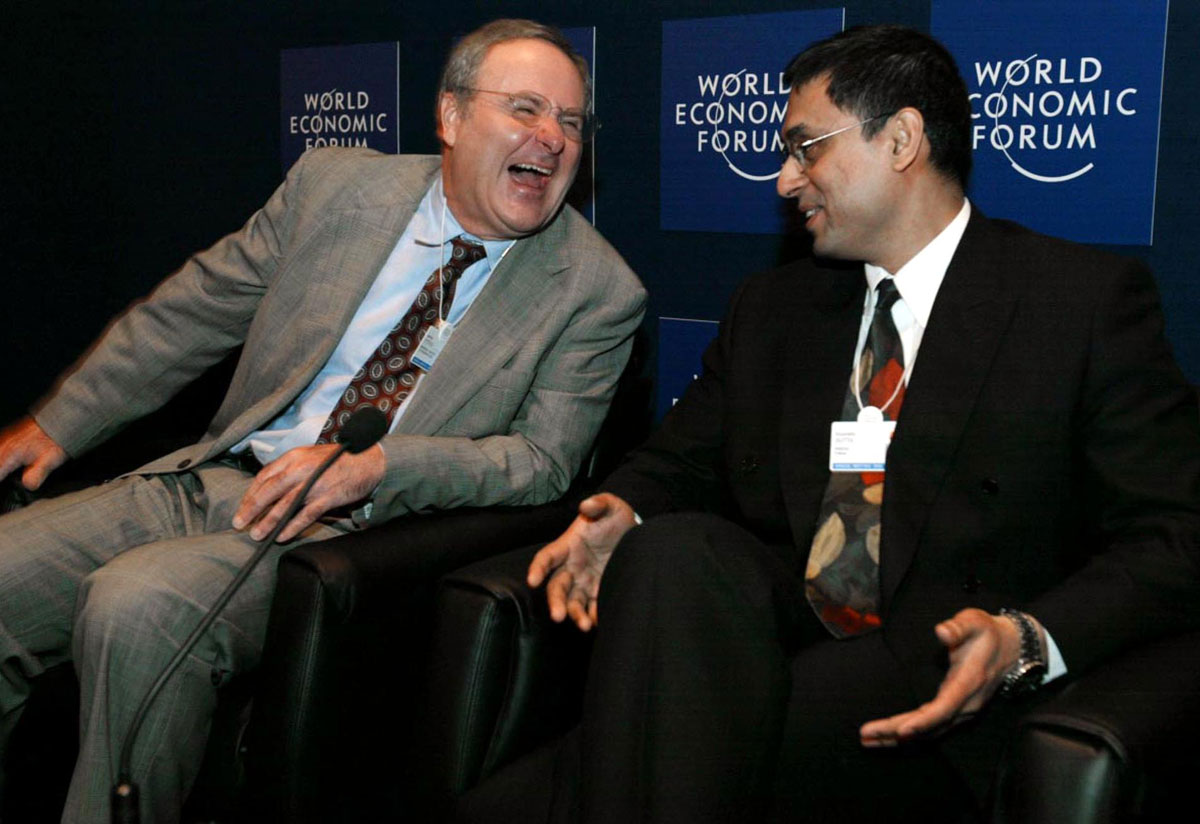INDIA ON 66TH SPOT IN MOST INNOVATIVE ECONOMIES, UP 15 PLACES
File photo of James O’Toole (l), Research Professor, Center for Effective Organizations, Marshall School of Business, Univeristy of Southern California, sharing a laugh with Soumitra Dutta (r), Professor and Dean of Technology and e-Learning, INSEAD, France, before their panel on management update, at the World Economic Forum at the Waldorf Astoria hotel in New York, Jan. 31, 2002. (Rick Maiman | AFP | Getty Images)
India has been ranked 66th in a list of most innovative economies, jumping 15 places from last year, according to a new UN report which calls for more transparent policies if the country aspires to become a global driver of innovation, writes Yoshita Singh. – @Siliconeer #Siliconeer #India #IndiaEconomy #IndiaGrowth #UnitedNations #UN #WIPO #INSEAD
In the report by the UN World Intellectual Property Organization (WIPO), India moved up 15 spots from 81st last year to 66th this year in the overall global rankings.
The Global Innovation Index 2016, released by the WIPO, Cornell University, and the multi-nation business graduate school INSEAD, said India ranks among the top 50 economies overall in two pillars: Market sophistication, 33, and Knowledge and technology out-puts, 43.
The country maintains stable or improved rankings across all pillars, with the most significant improvements in Human capital and research, up 40 spots and Business sophistication, up 59 spots.
Within Human capital and research, India data coverage increased, specifically in graduates in sciences and engineering, ranked eighth overall this year while this was a missing value last year, affecting the jump in its ranking.
India’s ranking in the Business sophistication pillar is affected most by a substantial improvement in Knowledge workers, up 46 spots and Knowledge absorption, up 33 spots.
India also improves in the ranking of firms offering formal training by 56 spots to reach 42nd place.
“Furthermore, India improves across all indicators within the Knowledge absorption sub-pillar and it turns in a solid performance in the GII (Global Innovation Index) model’s newly incorporated research talent in business enterprise, where it ranks 31st,” the report said.
However, India shows weakness in two sub-pillars of business environment, 117th, and education, 118th and within this has potential to improve in the ease of starting a business and pupil-teacher ratio.
“India has all the ingredients needed to become a global driver of innovation: A strong market potential, an excellent talent pool and an underlying culture of frugal innovation.
Innovative countries have demonstrated the leverage of their cultural advantage to capture markets,” the report said.
Similarly, India can build on its cultural bias of frugality and sustainability to capture markets not only within its shores but globally.
“For this to happen India’s industries need to have the hunger to be at the top of the value chain, its customers have to be more demanding, its policies have to be more transparent, and its talent pool has to get more hands-on experience while simultaneously growing to leverage the global talent pool,” the report said.
The report showed that for the first time, China, a middle-income country, has joined highly developed economies among global leaders in innovation.
“China’s progression reflects the country’s improved innovation performance as well as methodological considerations such as improved innovation metrics in the GII,” WIPO said.
However, despite China’s rise, an “innovation divide” persists between developed and developing countries, it said.
Switzerland emerged as the global leader among innovative economies followed by Sweden, the UK, the U.S. and Finland.
Switzerland ranked first in the 2015 index as well.
WIPO also noted that the 2016 findings point to an increasing awareness among policymakers that fostering innovation is crucial to a vibrant, competitive economy.
“Investing in innovation is critical to raising long-term economic growth. In this current economic climate, uncovering new sources of growth and leveraging the opportunities raised by global innovation are priorities for all stakeholders,” WIPO Director-General Francis Gurry said.
According to WIPO, among the GII 2016 leaders, four economies Japan, the U.S., the UK, and Germany stand out in “innovation quality”, a top-level indicator that looks at the caliber of universities, number of scientific publications and international patent filings.
China ranked 17th in innovation quality, making it the leader among middle-income economies for this indicator, followed by India, which has overtaken Brazil. However, Sub-Saharan Africa continued to lag behind.
Mauritius took the top spot among all economies in the region, 53rd, followed by South Africa, 54th, Kenya, 80th, Rwanda, 83, Mozambique, 84, Botswana, 90th, Namibia, 93th and Malawi, 98th.
Average regional performance shows strengths in the ease of starting a business, information and communication technologies, business-model creation and relative expenditure on education, with weaknesses in firms conducting global research and development, high-tech exports, the quality of local universities and number of scientific publications.
Co-editor Soumitra Dutta, Dean at the Cornell College of Business, highlighted the importance of investment in improving innovation quality as essential for closing the “innovation divide.”
Dutta said, “While institutions create an essential supportive framework for doing so, economies need to focus on reforming education and growing their research capabilities to compete successfully in a rapidly changing globalized world.”
The Global Innovation Index 2016 ranked nations according to their innovation capabilities and results using approximately 80 indicators that include measures of human capital development and research, development funding, university performance and international dimensions of patent applications, among a host of other important parameters.


